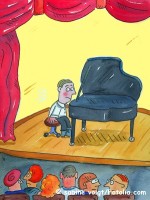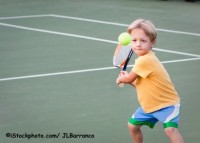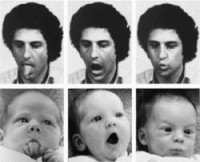You are at a concert and find that you are becoming increasingly tense, uncomfortable, and nervous as the performer experiences several memory lapses. You know by the look on a  student’s face as he comes to your studio that he hasn’t practiced during the past week. A stranger smiles at you as you walk down the street and you smile back, suddenly feeling happier. You know when your spouse grabs the grilling tongs while you are enjoying dinner outdoors that he isn’t about to turn the vegetables on the grill, he’s going to throw the tongs at the woodchuck that’s gnawing on a tree in your yard (strange, but true).
student’s face as he comes to your studio that he hasn’t practiced during the past week. A stranger smiles at you as you walk down the street and you smile back, suddenly feeling happier. You know when your spouse grabs the grilling tongs while you are enjoying dinner outdoors that he isn’t about to turn the vegetables on the grill, he’s going to throw the tongs at the woodchuck that’s gnawing on a tree in your yard (strange, but true).
Why are we able to instantly “read” or understand these situations, to vicariously experience someone else’s feelings, to understand their actions or intentions? A fascinating explanation has developed over the past twenty years: mirror neurons. Mirror neurons are amazing, specialized brain cells that allow us to understand the actions, intentions, and emotions of others through unconscious “mirroring” or imitation in our own brains. The discovery of mirror neurons is one of the most exciting discoveries in neuroscience in the past two decades. They have huge implications for musicians – for how we learn to play an instrument, how we perform, how we perceive the performance of others, and even how we actually hear music. And as we talk about mirror neurons in the next few posts, the research findings of Chia-Jung Tsay concerning visual dominance in listening to performance that we discussed in the previous three posts begin to make a lot more sense.
As recently as the 1980s, scientists thought that action, perception, and cognition were three separate domains in the brain. Playing a musical instrument, for example, activated one area of the brain; perceiving someone else playing an instrument activated another; and cognitively understanding that an instrument was being played activated yet a third. Scientists believed that we used logical thought processes to interpret and understand the actions and emotions of others.
But then came the discovery of mirror neurons and that paradigm was turned on its head. The existence of mirror neurons showed that we “read” the world, not by cognitive processing (although there is definitely a place for that as well), but by mirroring in our own brains the actions, intentions and emotions of others. When we watch a couple embrace on television, some of the cells that are activated in our brain are the same cells that are activated when we ourselves embrace someone whom we love. Our brain isn’t responding just to the visual information of the embrace, some neurons in the motor area of our brain are also activated – as though we are actually doing the embracing ourselves. When we listen to a live performance of someone playing a piece of music that we play, the visual area of the brain is activated, but so are some neurons in the motor areas – as if we were playing, and we sometimes find our fingers moving while we listen.
I am saying “some” neurons because not all neurons in the brain are mirror neurons. Based on what they have found in the brains of monkeys, some scientists estimate that, in humans, probably about 20% of the brain’s motor neurons are mirror neurons, and about 10% of the sensory neurons are mirror neurons. But these are only estimates. No one really knows.
When you see someone running, you don’t cognitively process what you are seeing: “Oh, that person is moving quickly; his arms are pumping; his feet are higher off the ground than if he were walking; he is breathing fast, this must be running.” We know instantaneously that what he is doing is running because our mirror neurons for running are activated. But mirror neurons aren’t just activated by seeing. What’s interesting is that they are are also activated if we are only hearing the sound of running and even if we see or hear the word run.
 And how do you know so quickly by the look on your student’s face that he hasn’t practiced? Emotion, as communicated by the face, voice, and body movements, is an active motor process, and facial expressions are the outward manifestation of an emotion. So you are mirroring your student’s facial expression and therefore understanding instantly what he is feeling. You don’t have to think about what the boy in the photo at the left is feeling. You know it is determination because your brain is mirroring his facial expression and body stance.
And how do you know so quickly by the look on your student’s face that he hasn’t practiced? Emotion, as communicated by the face, voice, and body movements, is an active motor process, and facial expressions are the outward manifestation of an emotion. So you are mirroring your student’s facial expression and therefore understanding instantly what he is feeling. You don’t have to think about what the boy in the photo at the left is feeling. You know it is determination because your brain is mirroring his facial expression and body stance.
Obviously, we don’t carry out every action or express every emotion that is being mirrored in our brains. Other brain cells prevent us from doing so, but unconscious imitation by mirror  neurons is a primary catalyst for learning. Mirror neurons are active within minutes of a child being born. In a now-classic experiment conducted in the mid-1970s by Andrew Meltzoff, infants between 12 and 21 days of age were shown on videotape to be imitating facial gestures (see photo at right). He later repeated the experiment with infants as young as 42 minutes – with the same results. This, of course, was before the discovery of mirror neurons, but it is a perfect demonstration of them. And other recent experiments specifically studying mirror neurons have shown the same imitation in infants as Meltzoff found.
neurons is a primary catalyst for learning. Mirror neurons are active within minutes of a child being born. In a now-classic experiment conducted in the mid-1970s by Andrew Meltzoff, infants between 12 and 21 days of age were shown on videotape to be imitating facial gestures (see photo at right). He later repeated the experiment with infants as young as 42 minutes – with the same results. This, of course, was before the discovery of mirror neurons, but it is a perfect demonstration of them. And other recent experiments specifically studying mirror neurons have shown the same imitation in infants as Meltzoff found.
 By the age of two, children are learning primarily through imitation via mirror neurons. Children imitate each other all the time, as evidenced by the siblings in the photo at the left. No doubt one child stuck out his tongue and the other instinctively followed. Little boys imitate their fathers, as you see below, and little girls their mothers. Imitation is how we learn as children. As we mature,
By the age of two, children are learning primarily through imitation via mirror neurons. Children imitate each other all the time, as evidenced by the siblings in the photo at the left. No doubt one child stuck out his tongue and the other instinctively followed. Little boys imitate their fathers, as you see below, and little girls their mothers. Imitation is how we learn as children. As we mature, we begin to incorporate more deliberate cognitive processes into learning, but mirror neurons are still being activated every time we observe an action, and learning is still facilitated through the mirror neuron network (we’ll talk soon about what that means in terms of learning to play an instrument).
we begin to incorporate more deliberate cognitive processes into learning, but mirror neurons are still being activated every time we observe an action, and learning is still facilitated through the mirror neuron network (we’ll talk soon about what that means in terms of learning to play an instrument).
Mirror neurons are a very substantial topic – far too much information for one post, so stay tuned for the fascinating story of the discovery of mirror neurons; more on mirror neurons in movement, intention and emotion; and mirror neurons and music and how we can use our understanding of them as we learn, teach, and perform.
5 responses to “Mirror neurons and music, part I”
Fascinating. I’ve known about them for some time, but haven’t paid much attention. But, for early learning, they are crucial. More, please!
Thanks, Loren. There will be another post very soon.
What a great overview. Looking forward to the next posts.
Very interesting post. As a cellist and a licensed Body Mapping teacher I know that mirror neurons are a powerful force in learning. But as a mother and a grandmother I have observed that little boys and girls imitate both parents, not just their same sex ones.
You’re absolutely right, Sherill. Children do imitate both parents. It’s just sometimes more obvious with parents of the same sex.